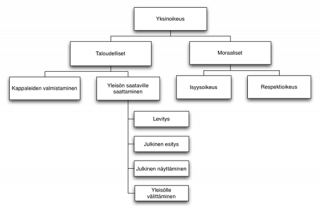Copyrights protect products of intellectual creative efforts; in this context, they are called works. The protection is automatic and does not require registration or using a special notation. Authors get copyright to their works when threshold of originality is met. The threshold of originality is met if the work is an independent and original product of the author’s intellectual, creative efforts. Copyright only protects the form of the work. It does not protect the idea, the substance or the theories included in the work – these can be freely used by others. Copyright empowers authors to decide how their works are used and sell licences to them for a compensation.
Author
- Copyrights always belong to natural persons. Companies can not have copyrights.
- Authors are entitled to allow or prohibit the use of their works by their exclusive right.
- By their exclusive right, authors determine the terms and conditions of usage, such as the amount of compensation payable.
- Authors can also prohibit the use of their work and demand that unauthorised use of their work be ceased.
Copyright
Copyrights of works can be divided into two categories:
- Economic rights
- Reproduction of the work
- Making the work available to the public
- Moral rights
- “Paternity right”: the right to be stated as the author (e.g. the photographer)
- “Right to be respected”: an obligation to respect the work so that it is not altered in a manner that is offensive to the author

Authors can sell or transfer the economic rights for their works. The moral rights are mostly untransferable.
Transferring a reproduction of the work does not entail transferring the copyright. For instance, if you buy a poster, you are not allowed to copy and sell or transfer it to somebody else. You also need a permission to alter works.
Rightholder
Rightholder is the person who owns or controls the copyright. They can be a natural person or a legal person and own all or part of the rights. Rightholders include:
- Publishers
- Producers
- Authors
“Paternity right”
The name of the author has to be stated in a manner required by proper usage:
- When the work is used
- When the work is reproduced or made available to the public
- Including digital channels
Term of copyright
Copyright does not last forever. The copyright period of validity is called the term of copyright. After the end of the term of copyright, the work can be used for free and without permission. The term of copyright is 70 years after the end of the year of the author’s death. If all the authors have died over 70 years ago, a work is free of copyright.
Rights related to copyright
Rights related to copyright protect material related to creative work that is not directly protected by copyright. Rights related to copyright protect, among other things, the work of performing artists and producers of video and audio recordings. The term of rights related to copyright is 70 or 50 years from the end of the year of performance, recording or publishing. The term of copyright for works originating within the European Economic Area or EEA (the EU member states plus Norway, Iceland and Liechtenstein) is the author’s lifetime and 70 years from the end of the year of their death. The term of copyright for works originating elsewhere is usually 50 years from the end of the year of the author’s death.
Agreement on copyrights
When transferring copyrights, you should draft a written agreement on the following matters:
- The temporal scope
- The geographical scope
- The technical scope
- Right to transfer the copyright on
- Right to modify
- Exclusive right or not
In employment relationships, employees’ copyrights are not automatically transferred to employers, except for software copyright, which is transferred to the employer unless there is an agreement that states otherwise.
Lawful use
- A work can be included in a photo or a video if it is of secondary significance (e.g. a painting visible in the background of an interview).
- Private use does not require a copyright licence.
- After the term of copyright has ended, works can be used freely.
- Quotation right: it is legal to quote published works in accordance with proper usage to the extent necessary for the purpose. When using the quotation right, you need to state the name of the quoted work and its author. Otherwise, the citation can be viewed as a copyright infringement.
Copyright organisations
Authors can transfer the control of commercial copyrights to a copyright organisation. These industry-specific organisations represent authors, artists and companies, collect compensation for copyrights on their behalf, manage licence matters and advocate for Finnish culture. Below, you can find a list of Finnish copyright organisations and sources of further information.
Kopiosto https://www.kopiosto.fi/en/frontpage/ represents a diverse group of creative authors and audiovisual artists, such as writers, visual artists, translators, actors, directors and journalists.
APFI ry https://apfi.fi/en/home/ represents the interests and manages the copyrights of production companies in the field of audiovisual content production.
Teosto
https://www.teosto.fi/en/ represents composers, lyricists, arrangers and music publishers.
Gramex https://www.gramex.fi/en/gramex-eng/ represents record producers and musicians.
Kuvasto https://kuvasto.fi/in-english/ represents visual artists.
Sanasto https://www.sanasto.fi/en/ represents literary authors.
The Ministry of Education and Culture https://minedu.fi/en/copyright drafts copyright-related bills for parliamentary decision-making and negotiates international agreements involving copyright.
Created by Kopiosto, Kopiraittila https://kopiraittila.fi/ (in Finnish) is an inspiring and exciting gamified site for teaching and learning about copyrights.
Software supervision and counselling https://www.bsa.org/
The Copyright Information and Anti-Piracy Centre (CIAPC) https://ttvk.fi/en/front-page

